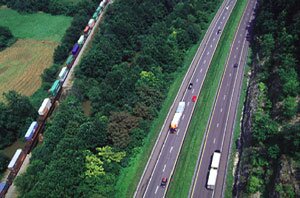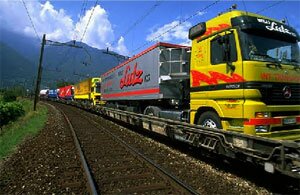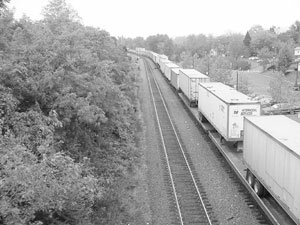Wrong haul? Group wants I-81 truckway derailed

Not too far in the future, in some hotspots, Interstate 81 might swell to eight to ten lanes. And in a few areas, the roadway could widen to 12 lanes– six in each direction, a vast Valley viaduct.
The expansion– at a cost of about $13 billion– would gobble up houses, businesses, and maybe even a Civil War battlefield or two.
And it would have tolls– a powerful incentive for truckers and others to find alternate paths, such as nearby Route 29, the already crowded artery that passes through Charlottesville.
There's another catch– in 30 years, it might have to be expanded again.
"If we allow a huge East Coast bypass to be built into our Mountain Valley topography, the impacts will be tremendous," says critic Rees Shearer.
Not the least of those impacts would be environmental. Additional lanes mean, obviously, more cars and trucks speeding up and down I-81 every day. The indirect effects of the additional traffic include more jobs and more population– which will themselves exert pressure on the interstate highway system in addition to primary and secondary roads, schools, and fire and rescue services.
And then there's the impact on drivers' wallets. Truck tolls would run from nine cents to 37 cents per mile, a cost that could top $120 for a trucker passing through Virginia.
"A toll road," Shearer says, "would divert truck traffic to other highways and put businesses and industries up and down the corridor at risk."
Proposed by Star Solutions, a private consortium that's negotiating with the Virginia Department of Transportation for the lead role in overhauling the highway, the dramatic expansion has plenty of critics. Unlike most critics, however, Shearer believes he has a solution– a rail solution.
Shearer's group is called quite simply Rail Solution, and its strategy would add just one lane of highway in both the northbound and southbound directions of I-81.
The core of the group's plan is a "steel interstate"– created by adding an additional track and myriad overpasses along the existing rail line that already parallels I-81 in the Shenandoah Valley. The idea is to increase capacity, eliminate grade crossings, and bolster train speeds sufficiently to provide a freight-shipping alternative to the long-haul trucks that make up 29 percent of all vehicles traveling on Virginia's stretch of I-81.
"We want to keep I-81 toll free and make it compete against a higher-speed railroad," says Shearer. "That's adding a whole new transportation benefit to the mix. If you just widen the highway and keep rail as a substandard service, it's not adding anything. And you're going to have to do the same thing at some point in the future when congestion becomes an issue again."
The steel interstate would run from Harrisburg, Pennsylvania through Virginia to Knoxville, Tennessee– and possibly on to Memphis and New Orleans. Shearer says that Virginia's portion would cost just over a quarter of the Star Solutions plan– $3.5 billion– while saving the environment and countless quantities of fuel and emissions by diverting about 40 percent of long-haul truck traffic from the roadway to the tracks.
However, VDOT has run some numbers– and what it has come up with doesn't look encouraging for those who support a rail solution.
According to a draft environmental-impact statement released by VDOT last month, the steel interstate would divert fewer than six percent of trucks that currently use the interstate in Virginia– at an actual price tag of not $3.5 billion, but $5 billion.
As rail advocates vociferously doubt the findings– "We find it almost impossible to believe that VDOT is correct," says Shearer– those in state transportation offices stand by them.
"Let's put it bluntly," says VDOT spokesperson Laura Bullock. "If rail would be profitable, private companies would be doing it already."
Indeed, the private sector doesn't appear interested– if Norfolk Southern Corp. is any indication. The railroad has repeatedly indicated that it has no plans to upgrade capacity of its Shenandoah Line.
Yet Shearer wants to persuade the governments as well as the mammoth railroad to see things in a different light.
"In the last five decades-plus we have been spending our federal and state transportation subsidies on the interstate system," Shearer says, "with some significant money going toward airlines and ports authorities, but we have allowed railroads to flounder." And flounder they have.
"Passenger rail was abandoned and left to starve," says Shearer. "Freight rail had more profit all along, so it's been able to survive, but in the meantime, literally thousands of miles of track have been taken up."
Bullock points out that it would take a major shift in public policy for "public money to be used on private transportation, which is basically what rail is."
However, after a bi-partisan move backed by outgoing governor Mark Warner, the state recently began awarding $23 million annually for private railroad improvements– as long as there are 30 percent matching funds from the owners– and a clear public benefit.
To Shearer, such benefits are obvious– and obviously wiser than spending billions on road widening. But VDOT disagrees.
"If you look at the traffic we expect on Interstate 81 in the year 2035, and you took every truck off the interstate, we would still have Thanksgiving weekend conditions every day of the year," says VDOT's Bullock, citing VDOT projections that 90,000 passenger vehicles would travel the I-81 corridor in Virginia.
"There would not be enough room out there for just cars," says Bullock. "And that's if you could take every truck off."
And, obviously, no rail option could remove every truck from the interstate.
"They couldn't," says Bullock. "You still have local deliveries, and deliveries on shorter trips, like between Harrisonburg and Bristol."
Folks at Rail Solution don't disagree. Trains and trucks are already "business partners," according to the group's literature. "Trains excel at long hauls, trucks at point-to-point delivery."
Still, there's that difference over the diversion– six percent vs. 40 percent. One reason for the discrepancy, explains Trip Pollard of the Charlottesville-based Southern Environmental Law Center, is that the VDOT study serving as the basis of ifs impact statement had a design flaw: it studied only in-state traffic.
"What's needed is a look at a multi-state rail solution," says Pollard, who calls for a "corridor-wide" study.
Bullock concedes that the VDOT study didn't contemplate a multi-state solution.
"Our study is under the purview of the Federal Highway Administration," says Bullock, "and they have said this is a Virginia-only study, so we have to comply with the direction they've set for us."
To Pollard, such limitations doom the value of VDOT's research. "This isn't a Virginia problem," says Pollard. "It's a federal problem. It's a multi-state problem. And it's going to require the input of the federal government and states located up and down the I-81 corridor to get to a workable solution."
Already, 37 Virginia cities, towns, and counties along I-81– Pulaski County's the biggest holdout– have supported a comprehensive rail approach in any effort to upgrade I-81.
VDOT says that it has listened to transportation officials from several I-81 states to see what can be done across state borders to take the pressure off the interstate highway.
"The folks in these meetings recognize the benefit of working together," says Fred Altizer, program manager for the I-81 improvement project at VDOT.
Altizer says members of the working group have shared information about what their respective states are doing relative to I-81.
"One common thread that binds us is that 81 is one of those commerce corridors in the United States that feed a large portion of the population in terms of goods and services," says Altizer. "Each state has been more than willing to acknowledge that. We just don't have a mechanism to bring this to life right now."
One thread that binds many drivers is a fear of driving on such a truck-packed roadway. In 1998, a spectacular car-truck collision near Roanoke claimed seven lives– including one set of parents in the infamous UVA baby-switch case. However, a civil suit filed in that case suggests that the car's driver was at fault.
Then there's the narrow width of the road. Designed in late 1950 to the '60s, I-81 is much narrower than newer interstates, with inner shoulders typically only two tire-widths wide, according to Bullock. Yet despite the trucks and the outdated design, I-81 may not foster widespread carnage.
Taking into account fatalities, injuries, and property damage, VDOT gives each of the state's interstates a "weighted crash score." The figure for I-81 is actually 42 percent below Virginia's interstate average. As for trucks, they constitute 29 percent of the vehicles on I-81– and 29 percent of the crashes.
But there's another growing complaint: traffic.
Emmett Hanger, a state senator who represents a wide swath of the Central Shenandoah Valley in the Virginia Senate, thinks the problem needs no further study.
"There's too much traffic out there," says Hanger (R-Mount Solon), "and we have to do something. Obviously, a lot of money has been spent to this point, and almost any armchair observer, given a ride up and down Interstate 81 and about five minutes to think about it, would come to the same conclusions as the report.
"Anyone who has an appreciation for our lifestyle and the sensitive environment in Western Virginia would come to the same conclusion," says Hanger. "You don't want to overbuild, and yet there are places that need immediate attention."
Hanger's solution: one additional lane in most locations on both sides of the interstate.
"A lot of that can be done with very limited environmental impact and study," says Hanger, "because it can be accomplished within existing right-of-way." A further benefit from operating in the existing right-of-way is lower cost.
If things don't happen Hanger's way or with a "steel interstate," things could move in the direction of Star Solutions' asphalting plan.
While Star touts its tolls as funding salvation, business and local-government leaders from Bristol to Winchester say tolls would kill the economy of the western third of the Commonwealth.
And the impact could very well extend into Central Virginia. According to a 2002 report commissioned by the Virginia Trucking Association and the American Trucking Association, a 10-cent per mile increase in the cost of using I-81– from tolls or other means– would be expected to produce a 11 percent decrease in truck miles traveled on I-81, with a 20-cent hike resulting in a 51 percent decrease.
Where will all those trucks go?
"Whatever is done to I-81 is going to have an enormous impact on Charlottesville and Central Virginia," Pollard says. "People have so much to deal with in Charlottesville and Albemarle County that we tend to view 81 as a Western Virginia problem. But there's no question that the tolls being talked about are going to divert a significant amount of truck traffic from 81 to alternate routes, and one of those is 29.
According to a report by ALK Technologies and its principal, Princeton professor Alain Kornhauser, truck traffic would climb 20 percent on U.S. 29 with just a 10-cent per mile increase in the cost of driving on I-81.
"Charlottesville and the 29 corridor have enough congestion issues to worry about," Pollard says, "without having thousands of additional trucks a day heaped on for good measure."
Star Solutions' critics are already starting to see encouraging signs. The federal highway bill that passed Congress last summer contained $142 million for truck lanes in Virginia.
While that sounds like a lot, Shearer says, Star Solutions had been hoping for $1.6 billion. In its proposal posted on VDOT's website, Star brags of finding such funds through Alaska's lone congressman Don Young, an avowed fan of separating cars and trucks.
However, later last year, Young, chairman of the House Transportation Committee, as well as Alaska Senator Ted Stevens, saw their much-derided "bridge to nowhere" stripped from the federal highway bill. The $223 million bridge would have linked a 50-person island to Alaska's mainland with a structure taller than the Brooklyn Bridge and nearly as long as the Golden Gate Bridge.
Then there's Star Solutions. A consortium of big companies, the name stands for Safer Transport and Roadways. Critics, however, can't help but note that the leader is KBR Inc., also known as Kellogg Brown & Root, a subsidiary of the infamous Halliburton Corporation.
As Shearer doesn't hesitate to point out, KBR is under investigation for overcharging the Pentagon for military support operations in Iraq. Another member of Star is McGuire Woods, the Richmond law firm that helped write Virginia's Public-Private Transportation Act, the law that enables a private company to build roads.
"These relationships are too cozy," complains Shearer.
"There are people here who have been involved in state government," says Tyler Bishop, spokesperson for Star. "But that only educates us in what the law does."
Bishop points out that two firms applied to become the I-81 contractor under the Public-Private law, which he calls a "tool to allow the private sector to make projects happen that the state can't afford do on its own."
VDOT and Star acknowledge they still in discussions for Star to handle the road upgrades, but Bullock points out that VDOT is not yet talking about what Star might build.
"We have to pick an idea first," stresses Bullock. Her colleague Altizer says that Virginians will get six or seven public hearings over the next two months with the Commonwealth Transportation Board making a decision later this year.
As for the notion that the $142 million federal appropriation was a rejection of truck lanes, Star's Bishop disagrees. "To the contrary," says Bishop, "it proves the project is alive and viable and that the Congress thinks is worthy of scarce federal dollars."
Nick MacNeil, a Staunton-based member of Rail Solution, is among those calling for a more thorough review of the state's options.
"Experts believe that intermodal freight-rail capacity will inevitably be expanded in the near future to handle demand, whether or not highways are widened," he says. "It would be a tragedy to triple I-81 highway capacity, with all the destruction that would entail locally, only to find that increased freight-rail capacity made that expansion unnecessary."

This is how Star Solutions would make I-81 look, it claimsby adding multiple lanes

This is how Rail Solution would makeover I-81, it claimsby placing tracks alongside the highway
PHOTO BY XXXX

Rail Solution wants more truckers to pull their rigs onto the rails.
PHOTO BY XXX

Would two freight lines with overpasses boost rail speeds on the Shenandoah line from 20 to 80mph?
COVER SIDEBAR- I-81 fast facts
* In Virginia, I-81 is 325 miles long, the longest interstate in Virginia.
* It has 90 interchanges.
* It closely parallels U.S. Route 11 and railroad lines.
* It stretches from Dandridge, Tennessee, at the intersection of I-40 through New York to the U.S.-Canada border.
* It links 21 Virginia cities and towns and 12 counties and connects I-64, I-66, I-77, I-381 and I-581.
* While designers expected only 8 percent truck traffic, they built the road to handle nearly double that– 15 percent– just to be safe.
* Surprise, surprise– trucks now account for 39 percent of total traffic on I-81, one of America's top eight truck routes.
* I-81's hills provide scenic thrills, but cause trucks to decelerate.
* Unlike I-95, its eastern counterpart, I-81 connects much smaller cities and towns without major "rush hours."
* Not surprisingly, therefore, I-81 has become a through-trucking route for drivers wishing to avoid big-city traffic.
* In 1956, under President Dwight Eisenhower, Congress approved major funding to launch the Interstate system.
*Construction of I-81 started in December 1957 from just north of Buchanan to just south of the Rockbridge County line, creating a stretch called the "Harrisonburg bypass"– only 10 months after Virginia's first public hearing.
* On December 21, 1971, I-81 was completed when a 14.4 mile stretch was opened from Dixie Caverns to Christiansburg.
* Traffic has tripled in the last 20 years, from around 20,000 vehicles per day to nearly 60,000 vehicles per day in the Roanoke Valley and Winchester regions.
* Still, AAA considers I-81 one of the nation's 10 most scenic interstates, the only interstate in the Southeast to earn that designation.
* In 2000, speed limits in the metro areas surrounding Harrisonburg and Roanoke were lowered from 65 mph to 60 mph
* In preparation for widening, concept studies began in 1996 with aerial photography, traffic counts, and traffic computer modeling. A nearly $12 million effort, the studies continue...
–all based from VDOT information
#